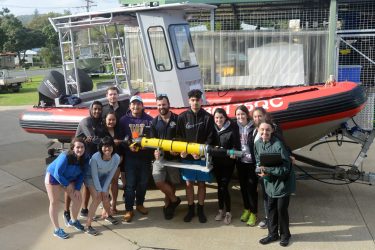Just because campus is quieter over the summer, doesn’t mean College of the Environment researchers are on vacation. From the tea plantations of Taiwan to the coral reefs of Australia to the glaciers of Greenland, UW Environment students and researchers had a busy summer deepening their understanding of the world around us both inside and outside of the classroom. Here are some examples of work done by researchers from various units, schools and departments within the College:
Exploring environmental and social resilience in Taiwan
13 students spent four weeks exploring environmental and social resilience in Taiwan on a Program on the Environment study abroad trip. This trip was a collaboration between the College and four different Taiwanese universities: National Taiwan University, National Changhua University of Education, National Kaohsiung Normal University and National Pingtung University. Students had hands-on learning experiences both inside and outside the classroom, including academic lectures, field trips visiting with local environmental groups, weeding in an organic tea plantation, and observing organisms in an intertidal zone facing pressure from wind farm development.
Engineers and scientists study seagrass in Australia

In conjunction with the UW Louis Stokes STEM Pathways and Research Alliance: Pacific Northwest (LSAMP) program, two researchers from the School of Oceanography led a group of 13 student scientists and engineers in a study abroad program in Queensland, Australia. At the Queensland University of Technology, students studied why seagrass and coral reef ecosystems are important, how to measure changes within these ecosystems and how to use robots to collect data. The class was co-taught by research engineer Rick Rupan and graduate student Isaiah Bolden, who formed an engineer/scientist team to expose students to real-world problem-solving and promote diversity of thought. The two led by example, showing students how engineering and science can work together to solve problems. Read the full story here.
Researching marine debris in Japan
School of Marine and Environmental Affairs graduate student Koarin Otsuka traveled to Mitakojima, Japan to conduct research for her thesis. There, she interviewed locals on how interactions between civil society and the municipal government affect how people on the island regard and respond to marine debris.
Studying wildfires west of the Cascades
Eight students in Assistant Professor Brian Harvey’s lab at the School of Environmental and Forestry Sciences headed to the west side of the Cascades to study wildfires, specifically in forests burned in the 2017 Norse Peak wildfire. The group of three graduate and five undergraduate students had a rare opportunity to study forests affected by fires west of the Cascades, and the chance to work in collaboration with the US Department of Natural Resources, US Forest Service and SEFS Professor Emeritus Jerry Franklin.
The team collected data measuring how the fire burned, the severity of fire on burned trees, ground cover and number of trees that died from the fire. The team also measured initial vegetation after the fire, including tree seedlings and many other species of plants that have come back in the first two post-fire years. In addition to using these measurements as data for current analyses, the plots are set up to be permanent and long-term to track data over the next several decades and beyond. Read more about Harvey’s wildfire research at his website.
#HarveyLab @UW_SEFS @UWEnvironment field crew measuring burn severity and pre-/post-fire forests in the 2017 #NorsePeak #wildfire on the west side of the cascades. Stay tuned for insights on #westsidefire from several projects with us and @CIG_UW + @waDNR + USFS collaborators. pic.twitter.com/a0AVJKAojY
— Brian J Harvey (@Brian_J_Harvey) August 8, 2019
From fires to ice
They’re the unicorns of the sea! School of Aquatic and Fishery Sciences‘ Associate Professor Kristin Laidre, SAFS graduate student Jenny Stern and Kate Stafford of the Applied Physics Lab worked on an interdisciplinary cruise in northwest Greenland, studying narwhals at glacier fronts in Melville Bay. As part of a three-year research effort, Laidre deployed underwater moorings at three sites and remote cameras on land, and worked with oceanographers to collect CTDs (an oceanography instrument measuring conductivity, temperature and depth in seawater) in the area.
Headed up to NW Greenland this week to study narwhals at glacier fronts in Melville Bay, just in time for the big melt event. pic.twitter.com/OsR2HGRNRn
— Kristin Laidre (@KristinLaidre) July 29, 2019
These are just a snapshot into all the great research done around the College of the Environment. For consideration in future news stories, please email coenvcom@uw.edu.

